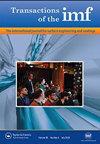Replacing TCA and CFC-113 with HFE and HFC based azeotropes and n-propyl bromide based solvents for wipe cleaning metal components: Source evaporation rates and models
IF 1.5
4区 材料科学
Q4 ELECTROCHEMISTRY
Transactions of The Institute of Metal Finishing
Pub Date : 1999-01-01
DOI:10.1080/00202967.1999.11871237
引用次数: 4
Abstract
SUMMARYIn replacing traditionally used solvents for external wipe cleaning applications with newer and more environmentally friendly solvent systems, account has to be taken of their volatility since this has a great bearing on the cost of the cleaning process as well as on occupational health hazards to operatives. To determine the concentrations of solvent vapour which will be produced in the workspace and to make sure that these do not exceed occupational exposure limits, it is necessary to know not only the workspace ventilation conditions but also the source evaporation rate of the solvent used. A study carried out to compare the evaporation rates of the traditional solvents under varying conditions to those of the proposed replacement substances is reported and a detailed discussion given of the usefulness of evaporation models to predict emission rates.用基于HFE和HFC的共沸物和基于正丙基溴的溶剂代替TCA和CFC-113擦拭清洁金属部件:源蒸发速率和模型
在用更新的、更环保的溶剂系统取代传统的用于外部擦拭清洁的溶剂时,必须考虑到它们的挥发性,因为这对清洁过程的成本以及对操作人员的职业健康危害有很大的影响。为了确定工作空间中产生的溶剂蒸汽的浓度,并确保这些浓度不超过职业暴露限值,不仅需要知道工作空间的通风条件,还需要知道所用溶剂的源蒸发速率。报告了一项比较不同条件下传统溶剂与拟议替代物质的蒸发速率的研究,并详细讨论了蒸发模型对预测排放率的有用性。
本文章由计算机程序翻译,如有差异,请以英文原文为准。
求助全文
约1分钟内获得全文
求助全文
来源期刊

Transactions of The Institute of Metal Finishing
工程技术-材料科学:膜
CiteScore
3.40
自引率
10.50%
发文量
62
审稿时长
3 months
期刊介绍:
Transactions of the Institute of Metal Finishing provides international peer-reviewed coverage of all aspects of surface finishing and surface engineering, from fundamental research to in-service applications. The coverage is principally concerned with the application of surface engineering and coating technologies to enhance the properties of engineering components and assemblies. These techniques include electroplating and electroless plating and their pre- and post-treatments, thus embracing all cleaning pickling and chemical conversion processes, and also complementary processes such as anodising. Increasingly, other processes are becoming important particularly regarding surface profile, texture, opacity, contact integrity, etc.
 求助内容:
求助内容: 应助结果提醒方式:
应助结果提醒方式:


